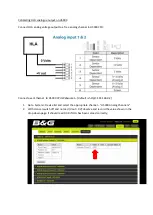
Copyright 2022 Baker Hughes Company.
English–PTC Temperature Calibrators | 9
3.3 Test Tasks
Test tasks are containers for defined test conditions. They are helpful for recurring testing
processes, for standardizing test sequences and for generating measurement logs.
All required settings and configurations for the calibration of an DUT are compiled in a test task.
The parameters of the testing task are saved and linked to the selected function and DUT. See
6.
The operation concept of the calibrator is based on pre-installed and self-defined test tasks. They
are a central component of the function and operation of the calibrator.
The emphasis of the operating manual is on the use of test tasks during operation of the
calibrator.
The calibrator is shipped with pre-defined functions, test samples and testing tasks. These have
been defined in the factory, in which the basic settings of the calibrator have been stored. If
desired, customer-specific test tasks can be created.
The protected test tasks can be neither be deleted nor edited. They serve as templates for your
own self-defined test tasks. They can be copied and then modified.
You can define your own test tasks for different DUT or test sequences. These test tasks are
directly saved in the calibrator and can be easily activated. This makes quick access to recurring
test tasks possible.
Upon switching on the calibrator, the first test task of the selection list is loaded automatically,
with the relevant parameters.
4. Commissioning and Operation
For safe operation of the calibrators, a formal commissioning procedure is necessary.
Commissioning includes the installation, electrical connections, preparation for the calibration as
well as correct switching on and off of the calibrator.
Further, a visual inspection for damage is required before use.
The required steps are described in the following sections.
INFORMATION
The function and the DUT are independent. During the
configuration of test tasks (Section
6), the respective expert mode can be
entered. This allows administration and configuration when selecting the
function or DUT.
Note that changes to existing functions and DUTs always affect all linked test
tasks.
WARNING
The calibrator may become very hot during operation. If the
calibrator is operated without supervision, third-party persons in the vicinity
could get injured. Moreover, flammable material could come into contact with
the calibrator and cause significant harm to personnel and/or damage to
property.
Never leave the calibrator unattended when it is in operation or in the cooling
down phase.
















































